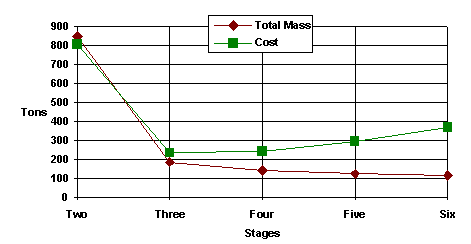
(antigravity can only be discovered by space colonists)
To stage or not to stage that is the question. Whether it is nobler in one's own mind to go SSTO or to "stage early and often".
While NASA has always tried to use the least number of stages, the Soviets (now Russians) always stacked several stages together to build their rockets. With the recent proposal for a single stage to orbit vehicle, this debate has taken a turn into the world of hype . I recently found a good analysis of the strength of the Russian philosophy. (Soviet Aircraft and Rockets, Zhemchuzhin) The calculation Zhemchuzhin makes gives a rough estimate of a rocket to place a 1 ton payload into an earth escape trajectory such as would be required for an interplanetary mission. It would have been nice if the calculation had been done for a low earth orbit launch but the results are comparable. All the stages are designed with a 0.9 mass ratio and an ISP of 306, typical of low cost Russian hardware. The graph below illustrates the results for a two to six stage rocket. A single stage rocket with this ISP would not even make it into orbit, much less to earth escape velocity. I've added a second line on the graph which is an estimation of the complexity and cost of the vehicle.

Maximum burn duration in seconds = ISP * Mass Ratio
and you might think that the longer you can burn the engines the better. For a single stage to orbit vehicle this number must be at least 400 or more. Of course reducing the thrust will extend the actual burn duration, but the total impulse will remain the same. For multistage vehicles it is also important to apply the big dumb booster philosophy to the lower stages, increasing their size but reducing their cost.
Of all the launch vehicles that have been used in the world, the most successful have been those that use two and one half stages, two stage vehicles have added boosters, one and one half stage vehicles add a second stage, leading one to the conclusion that this is a 2 1/2 stage planet. The Moon has been proven to be a single stage to orbit body, and the jury is still out on Mars.